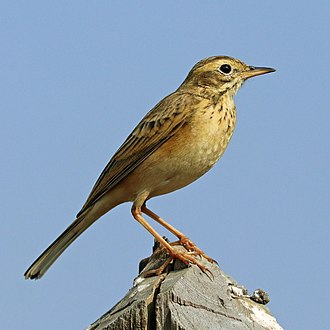Pipit
Among the Kendayan (Dayak Kenayatn) people of West Kalimantan province, Borneo, Indonesia, the star ν Pup is identified as "Pipit".
Etymology and History
ν Pup (then ν in Argo Navis) was identified as "Pipit", or sparrow, by ethnographer M.C. Schadee (1914) in a paper on time reckoning amongst the Kendayan ("Landak Dayak") people. It is one of a pair of stars (the other being ζ Pup) forming an asterism whose name was recorded by Schadee as Ensoelit. This is also the name of a bird -- "one that often causes great damage to rice in paddy fields". "The [two] rice thieves are close to Sirius" (link):[1]
"Ensoelit, naam van een vogel, welke vaak groote schade aan de te velde staande padi toebrengt. Ensoelit bestaat uit zeta en nu Argus. Nu Argus heet ook pipit = musch."
English
Ĕnsoelit, name of a bird which often causes great damage to the young rice plants ('padi') in the fields. Ĕnsoelit consists of ζ and ν argus. ν argus is also known as pipit = musch.
In modern Dutch the latter bird is known as 'mus' which Wikipedia calls a Old World Sparrow. Ensoelit is the Dutch ethnographer's transcription of a Kenyatan name which has not been found elsewhere. "Pipit", or "Burung Pipit" in Indonesian, has also been identified as Lonchura striata, i.e., the white-rumped munia or striated finch.[2]
The footnote identifies them as 'rijstdiefjes' = little rice thieves. They are also known as 'rijstvogels' of rice birds and are commonly known as Java sparrows.
Etypmology and Species of birds
There are also other species of bird called "Pipit", e.g. the American Pipit which lives in the Americas, Northeast and East Asia. However, the star name seems to be applied in Indonesia only. Today, the term designates a genus of small passerine birds.
However, the term "Pipit" occurred in European languages only in the middle of the 18th century and is considered probably imitative (cf. Oxford Languages). We consider the star name as indigenous Indonesian and the term in modern biology a take-over from this original.
Mythology
Naik Dango (also known as Gawai Dayak), a ceremony of the Dayak Kanayatn people, is a form of local wisdom that is a legacy of the ancestors of the Dayak people. It is an expression of gratitude and ritual to God (Jubata) so that the harvest in the coming year will also be abundant and free from pests and disasters.
The traditional Naik Dango ceremony originates from a myth among the Dayak Kanayatn people regarding the origin of the rice plant which comes from a stalk of rice belonging to Jubata on the Bawang mountain. One day, a sprig of Jubata's rice was stolen by a sparrow and fell into the hands of Ne Jaek, who was headhunting at the time. Since then, humans called Talino began to recognize rice as their staple food.[3]
The Dayak Simpakng Community avoids four kinds of birds as a sign of bad luck: owl (oleng kuap/burung hantu), sparrow (burung pipit), rock magpigie bird (gagurak/murai batu) and paddy kareo bird (keruak/kareo padi). This particular community believes that if those birds enter their house at night, a bad event will follow: they are a message from Satan or the devil who wants to disturb the people. In order to prevent the oath from coming true, they have to kill any birds that come in; otherwise they have to leave the house for three days. If they want to come back to the house, it must be ritually cleansed by a shaman using a chicken and rice as well as reciting mantras.[2]
IAU Working Group Star Names
While "pipit" is a Western bird name it also appears to be a local (Kenyatan) name for a bird, whether a sparrow or munia/finch. It is clearly identified by Schadee with ν Pup (SIMBAD). The blue (B8) giant star has 3.17 mag in V.
WGSN thanks Youla Azkurrula (from Bali, Indonesia) for valuable contributions to this topic.
We are unaware of any other cultural names for nu Pup.
Weblinks
Reference
- ↑ Schadee, M.C. (1914). “De Tijdrekening bij de Landak-Dajaks in de Westerafdeeling van Borneo”. Bijdragen tot de Taal-, Land- en Volkenkunde, 69, 130–139, p. 132 (link)
- ↑ 2.0 2.1 Yulius Yogi, M. Sofwan Anwari, S.M. Kartikawati (2019). "Etnozoologi sebagai pertanda oleh masyarakat dayak simpakng di desa mekar raya kecamatan simpang dua kabupaten ketapang" JURNAL HUTAN LESTARI, Vol. 7 (2) : 716 – 722, link
- ↑ https://kebudayaan.kemdikbud.go.id/ditkma/upacara-adat-naik-dango/





